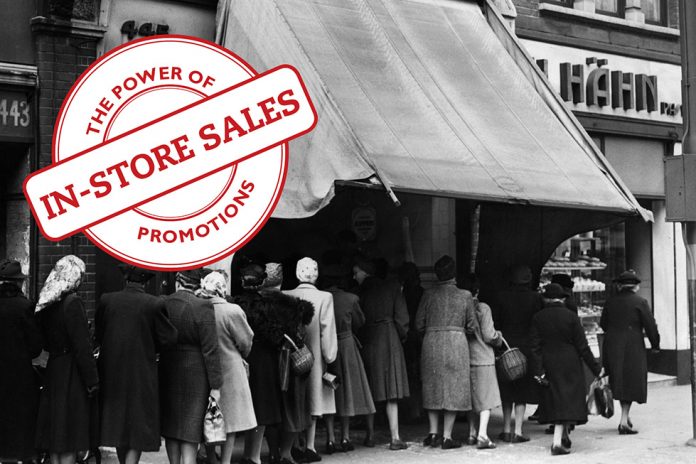What can in-store promotions do for you, and how do you avoid the pitfalls?
By Darrin Duber-Smith
Marketers just love to talk about value: creating it, delivering it, adding it to goods and services. In fact, the word appears in nearly all definitions of marketing one can find, and therefore it is a central consideration in the development, pricing, distribution and promotion of goods and services.
The world of promotion, which embodies just about every aspect of marketing communications, is replete with effective strategies and tactics designed to acquire and retain customers. One of the most effective elements of communication, especially at the in-store level, is the practice of using sales promotion.
Sales promotion is loosely defined as a value-adding activity, usually short-term in nature, whose purpose is to elicit a consumer response, usually measureable. Samples, coupons, contests, rebates, rewards programs and price reduction deals are all methods that have been successfully used by marketers for many decades. However, there is little doubt that the most effective sales promotions are executed in-store and involve a symbiotic relationship between brands, retailers, brokers, distributors and other intermediaries. These relationships can be rather complex and costly, especially if supply chain members fail to add value to the process themselves.
In-store strategies
Numerous studies over the years point to the same phenomenon—the importance of the in-store environment when it comes to consumer decision-making. Consumers digest all of the information they are exposed to regarding meeting a want or need and often enter the retail environment, whether in-store or online, with what is called an evoked set, which is an idea of what they would like to purchase ahead of time.
Temporary price reductions, coupons, in-store demos, packaging, shelf location, displays, visual merchandising, recommendations of store staff and many other techniques are good methods of helping consumers make a final decision or encouraging them to consider products outside of their evoked sets.
Research confirms that the majority of final decisions involving purchasing goods are made in the store itself, despite the best (or worst) intentions of the shopper. Many of these decisions rely on product packaging to interest consumers enough to change their buying decisions, if necessary. There is also an emphasis placed on the quality of the in-store environment, which is dependent on marketing support provided by product vendors. This is why successful cooperation between product marketers and retailers is of paramount importance.
Of the many in-store opportunities for marketers to engage customers, the most effective is probably the in-store demo. While it can be a very expensive endeavor, especially if done on a large scale, the opportunity to let a shopper try a product (which is the best way to elicit a purchase), get a coupon and speak with someone well-versed in the product and familiar with personal selling tactics is very hard to pass up for consumers. This is especially true for new product introductions and with customers who are not very familiar with natural health products.
In-store coupons, whether available at demo tables, on shelves as shelf-talkers or on product packaging have response rates that are much higher than any other couponing methods. Digital coupons offered on websites and through mobile devices are only beginning to catch on and currently represent a very small fraction of the total number. This will surely change as marketing activities switch to digital formats that are more efficient, measurable and truly one-to-one in nature.
In-store displays, including end caps, counter displays, prominent signage and anything involving a case stack discount have also been proven effective when planned and executed properly, all of which require the help and expertise of the vendor.
Collective collaboration
The benefits of such supply chain alliances are obvious. In-store promotions, generally paid for by the manufacturer, help move product. Manufacturers make products based on sales forecasts that attempt to adequately predict demand and match supply to fit. And with the help of brokers and distributors, manufacturers can effectively push products through the supply chain.
Such push strategies are often supported by national and local consumer marketing campaigns, marketing communications materials, displays, discounts, cooperative advertising dollars, slotting fees, demo support and store personnel trainings, among many others to encourage shoppers to pull products off the shelves.
This constant push/pull effect is the magic that moves goods through the supply chain. Retailers, who tend to have the most power in the supply chain due to their proximity to consumers, must do their part to get customers into their stores as well. Despite the proliferation of digital options, television and radio advertisements as well as direct mail are still the most common techniques used in retailer-to-consumer pull marketing, though e-mail marketing campaigns continue to gain popularity among retailers since they help develop customer loyalty and generate return shoppers.
Issues and pitfalls
Supply chain relationships do have their problems. Below, we outline five common problems with supply chain relationships, which marketers must do their best to address.
- Lack of vendor support is a common issue. Failure to leverage the branded product-retailer relationship with at least some of the support methods discussed earlier will certainly result in poor sales promotion performance as well as animosity on the part of the retailer who needs support in order to move the goods off shelves.
- On the other side of the coin, retailers must do their best not to squeeze suppliers for every penny since such tactics tend to leave the manufacturer with very little money left for retailer support. This is especially true for smaller players.
- Poor communication is always a problem, leading to gaps in expectations and all sorts of other issues. Improperly executed in-store promotions can be a problem. All arrangements should be clearly spelled out in writing before execution, and store personnel adequately trained.
- Expectations are one thing; measurable objectives are quite another. It’s tough to evaluate whether or not a sales promotion has been successful without setting actual numbers that need to be reached. Counting samples given, coupons redeemed, products purchased and contacts made is necessary, and mutually agreed-upon objectives get everyone on the same page, while providing crucial metrics for program evaluation.
- Despite the best efforts of all parties involved, simple “market failure” can ruin the best-laid plans. Offering some combination of the wrong product, wrong place, wrong time, wrong price and wrong message will ensure failure. And even when marketers do get these things right, environmental conditions such as the economy, new laws, emerging social trends, changes in the natural environment and many other uncontrollable external factors can affect results. These factors tend to place stress on any relationship.
Simply put, marketers of branded products and the retailers that sell them need each other to be successful. A product that is sold directly to the consumer can only enjoy so much velocity, and a retailer can only get so far with its store brand offerings. For this relationship to be a sustainable one, both parties must exercise mutual respect for one another and set agreed upon expectations including measurable results. Branded product manufacturers must engage in both push and pull marketing, including a major emphasis on the in-store promotional environment. Retailers must also do their part to add value to the process by making sure that the promotion is executed as intended by the manufacturer. Like any relationship, the manufacturer-retailer arrangement can be a wonderful thing, or a little piece of Hades. One thing we do know for certain is that such relationships can either add or subtract value for consumers depending on how well they are managed, and bad relationships don’t last very long.
Darrin C. Duber-Smith, MS, MBA, is president of Green Marketing, Inc., and senior lecturer at the Metropolitan State University of Denver’s College of Business. He has almost 30 years of specialized expertise in the marketing and management profession including more than 20 years working with natural, organic, and green/sustainable goods and services. He was a co-founder of the Lifestyles of Health and Sustainability (LOHAS, c. 1999) market/industry model and was leader of the first U.S. industry task force that helped frame the Natural Products Association’s definition of natural (c. 2005). He has published over 80 articles in trade publications and has presented at over 50 executive-level events during the past 15 years. A frequent media contributor and recipient of The Wall Street Journal’s In-Education Distinguished Professor Award in 2009 and WSJ’s Top 125 Professor Award in 2014, Mr. Duber-Smith is author of Cengage Learning’s “KnowNow! Marketing” blog at http://community.cengage.com/GECResource/blogs/marketing. He can be reached at DuberSmith@GreenMarketing.net or ddubersm@msudenver.edu.









